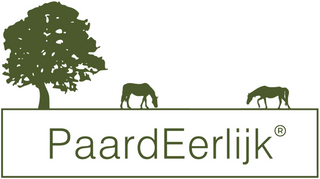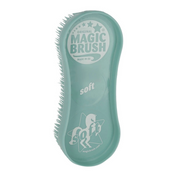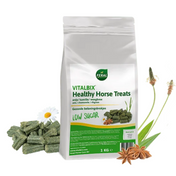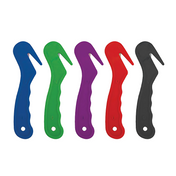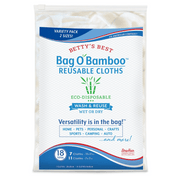Hay nets and slow feeders are widely used solutions in the horse world and are indispensable in many natural horse housings. But which hay net is best suited to your situation? To find the best hay net for your horse, we have listed the most important points of attention, with regard to the effect and the health of your horse.
We now know that roughage is extremely important. And that for a healthy gastrointestinal tract it is also important that horses have access to sufficient roughage throughout the day. The chance of stomach ulcers and discomfort increases significantly if a horse does not have access to roughage for more than three hours.
Unlimited roughage for horses
In response to this roughage requirement of the horse, a new standard has been born. The unlimited feeding of roughage. But unfortunately, for many horses this has consequences for another health issue; overweight. And strangely enough, we seem to find that much less serious.
As a solution to the logistical problem that unlimited roughage feeding entails, we now often place a whole hay bale of 400 kg in the paddock or fill several large bins with abundant hay. Completely understandable if it also concerns a herd with more horses. But unconsciously horses are getting fatter and fatter.

Obesity and loss of self-regulatory capacity
Unconsciously, we pay too little attention to the quality of the roughage and it seems especially important that it is always there. As a result, overweight will become a serious problem and many horses will lose their own self-regulating ability. They keep eating and can no longer stop. And this way of feeding hardly stimulates movement. Which makes the effect extra disastrous.
Fortunately, more and more people are becoming aware of this phenomenon and are therefore increasingly choosing to use hay nets or slow feeders. A way of feeding that slows down and ensures that horses have to make more effort. In addition, less valuable hay is lost.
But is that a trend that is ultimately better for the horse? To be completely honest, a smaller mesh has many advantages, but unfortunately also a number of disadvantages.
What an expert says about slow feeding horses
Femke Dölle, Expert in the field of natural housing and Passive Physio (a method to passively train the horse and use its body correctly) saw in her practice many discomforts in horses due to the use of slow feeders. She also knows a lot in the field of biomechanics and saw what structural feeding through a small mesh could mean for some horses.
When horses are forced to eat their entire hay ration through a small mesh, they make a different kind of head and neck movement throughout the day than they would in nature.
And that day in and day out. You can imagine that this will cause overload or discomfort at some point. In addition, some horses experience it as stressful if they have to make an effort for every tuft. However, it must be taken into account that the height of the net and the position in which the horse is 'forced' to eat can also have a reinforcing effect on this.
Perhaps you can't see the forest for the trees. But if you read the lines above carefully, you will have noticed that the core of many problems can be solved with high-quality roughage. And that means: good dry (and varied) hay with a low sugar content (7% or lower). Despite the fact that it has been difficult to get good hay in recent years, it does not make it any less necessary. In addition, the factor of exercise is also essential to be able to deal with a lot of food.
If you are currently using a slowfeeder in mesh three and your horse is struggling with health problems such as being overweight or having insulin resistance, then that is a situation in which it is very unwise to stop slowfeeding immediately or completely. This mesh can be very helpful in these situations. But do look for a change so that in the long term you may need mesh 3 less.
Which mesh slow feeder or hay net do you choose?
There are various mesh sizes available. Ranging from mesh 2.5 to 6 or larger.
When choosing a type of hay net, consider the following factors:
- The health situation of your horse. (too fat or too thin, other problems)
- The type of roughage available (coarse or fine, high or low sugar, etc.)
- Your own influence on housing and hay purchasing
- The presence of alternative sources of roughage and diversity
Below you will find a general guideline to help you determine which mesh size of a hay net is most appropriate for you:
Mesh 6cm: A large mesh that can be used to offer hay without delay and without it blowing away.
- Anti-spill, this mesh no longer slows down work
- No physical discomfort when used correctly.
- All types of long-stemmed roughage are suitable, provided they have a low or appropriate sugar content. Preferably have a hay analysis done.
- For healthy horses with a healthy weight and well-functioning self-regulation
- With a sufficiently varied supply of plant diversity in addition to hay
- Suitable for variable positions
View our range of hay nets in Maas 6
Maas 4.5cm : A less strict mesh that allows horses to spend a little longer on the roughage, with a lower chance of physical discomfort
- Less slow feed effect with fine hay, the delay also depends on the dexterity of your horse.
- More suitable for coarser roughage or straw than mesh 3.
- If you want to slow down a bit but limit the challenge for your horse.
- Also suitable in the transition to a larger or smaller mesh.
- Suitable for variable positions, preferably in combination with mesh 6.
View our range of slow feeders in mesh 4-5 cm
Maas 3cm: A more therapeutic choice of a slowfeeder. To limit the adverse effects of overeating or the intake of too many sugars per unit of time. Or to extend the duration of availability of roughage (for example during the night). This mesh needs more observation when used for the benefit of horse welfare.
- From this mesh or smaller it is really called a slow feeder
- Horses have considerably more challenges with eating.
- Horses still have time to learn to eat through a slow feeder. Many horses quickly understand how it works but some horses have too little intrinsic motivation for this and become very stressed, in that case choose mesh 4.5 or larger.
- For horses that urgently need to lose weight, suffer from metabolic problems such as insulin resistance or laminitis (always ensure sufficient roughage in these situations, do not give too little, but ensure distribution by using a slow feeder).
- For horses that eat too fast
- In case of less suitable roughage with higher sugar contents (it is preferable to adjust the roughage in that case)
- Less suitable for coarser roughage types, as this makes it even more difficult for the horse to eat.
- Possible impact on physical discomfort and frustration, so continue monitoring
- For larger portions of roughage, preferably use a trough
- For younger horses or horses with existing problems in the head and neck area, choose a larger mesh.
View our range of real slow feeders with a small mesh
How can you consciously use a slow feeder with mesh 3 with less chance of these adverse effects on the body?
If your horse or herd of horses does need some delay and you use a solution with a 3 cm mesh, make sure that in addition to this small mesh you also vary with other nets with a larger mesh. Hang up various 'satellite portions' in e.g. mesh 4.5 or 6 cm. This way, the entire hay ration does not have to be eaten through mesh 3.
Pay attention to eating posture
In addition, it is good to look at where mesh 3 hinders your horse the least. Give a basic portion in mesh 3 so that your horse can eat and pick it in a comfortable position. Preferably in grazing position. Use a low pallet box for this, or half IBC barrel in which you attach hay nets or a cushion. A slow feeder rack is also very handy and ensures that you can fill quickly.
Slow feeder in the stable
If your horse is stabled at night and only gets a few kilos of feed in a hay net then you can consider working with two meshes. For example, a third of the portion of hay in mesh 4.5 and the rest in mesh 3. This way your horse will take the longest over the smallest mesh, but he does not have to pull everything through mesh 3. Be as creative as possible in this. Also vary the place and height of hanging regularly, so the movement also varies.
How do you make the transition from slow feeders in mesh 3 to hay nets in mesh 6?
A slow feeder is of course a 'measure'. One that, just like a grazing muzzle, falls under the heading 'medical aid'. And if your horse needs this because otherwise it will not be doing well with your horse, it is good to have as a starting point that this is temporary. Because it is of course always good to strive to have to take fewer measures. A slow feeder gives you time to adjust the habitat or the type of roughage without the metabolism of your horse further deteriorating due to the sugars. But the starting point should be as much as possible that this is temporary or will eventually be a combination with the use of a hay net in mesh 4, 5 or 6 as described above.
If you want to make the transition to unlimited feeding, you will have to meet a number of conditions. First of all, the quality of your roughage is very important. In addition, it is important that your horse has a varied ration with sufficient diversity. View the possibilities of creating hedges or flower beds with plants that are suitable for horses to eat. View our range of eBooks with lots of practical inspiration!
And it is important that your horse has a healthy metabolism so that the self-regulating capacity can be used. Is your horse too fat and would you like to tackle its metabolism instead of just losing weight? I would like to help you take the first steps towards a healthy weight but also towards a healthy metabolism. Because losing weight alone does not give a healthy metabolism.
Of course, this transition is not within everyone's reach, not everyone can influence the type of roughage that is available or the times during the day when it is made available. But then make a choice within which you choose the least undermining for your horse's health. Within domestication, it is simply the case that you sometimes have to choose between the 'primarily less ideal solutions' because the horse simply no longer has control over that itself.
Safety when using slow feeders.
Of course, this is also a topic that comes up regularly when you use attributes with your horse. This often concerns a bit of positioning and variations in hanging. Make sure you don't hang a hay net too high. Between bow and knee is a good target point, and also take into account the sizes in a varied herd.
If your horse has shoes, a low application is not recommended unless you use a hay trough in which you use a hay net or slow feeder. Make sure that not everything is given at height, but that a considerable part can also be eaten in grazing position.
And lastly, prevent horses from getting stuck or entangled in any way. Preferably use a brakeway between fixed connections, especially with nets with multiple attachment points. For this you can use a set of Use slowfeeder tie-wraps . These do not come loose too quickly but do give way when you hang a lot.
